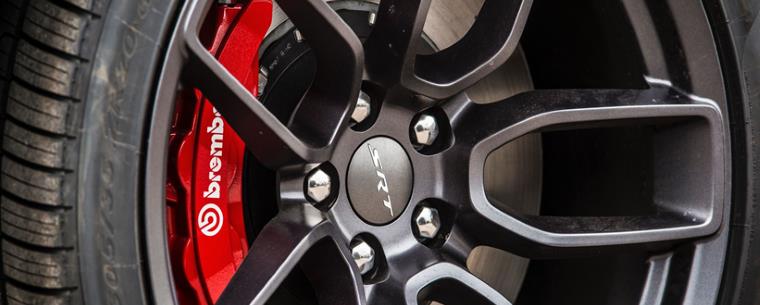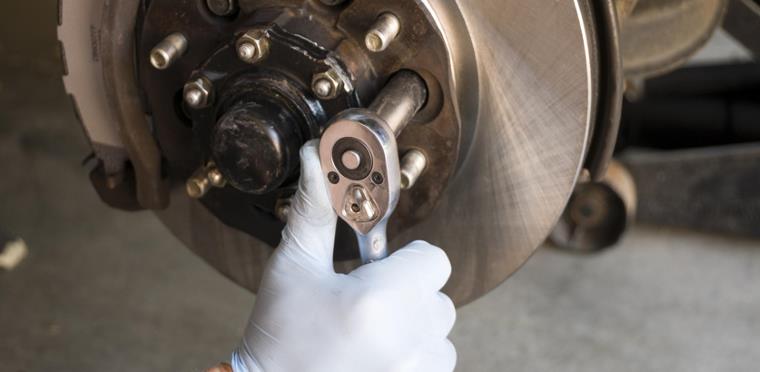Should brake discs get hot?
Kwik Fit | Friday 2nd August 2019 12:14pm

Your carís brakes work by converting kinetic energy (the motion of your wheels) into heat so that your vehicle can safely come to a stop. This means that itís completely natural for brakes to get hot in order to stop your vehicle.
But when do hot brakes become dangerous? Weíve answered this question and more in this helpful article. Read on to find out what hot brakes can do to your vehicle.
How do car brakes work?
Before we can think about how hot our vehicleís brake discs get, we need to understand how the brakes work.
To slow your vehicle down, you press down on the brake pedal. When you do this, brake fluid travels to your brake calipers. The harder you press the brake, the more fluid is applied to your brakes. This is called hydraulic force multiplication.
After this, the brake pads that are positioned either side of the brake disc, or rotor, will squeeze together, trapping the rotating brake disc in the middle. As the brake pads close around the rotor, they slow it down, causing your car to decelerate. It is this action that causes a lot of friction. Friction produces heat, which is why your brake discs may become hot after braking for a prolonged period of time.
It takes a lot of pressure to stop a one tonne vehicle. This is why you need to keep your brakes maintained and ensure that they're working properly, otherwise you could cause a serious accident.
How hot should brake discs get?
Now weíve determined that itís okay for your brake discs to get a little bit hot, but whatís the maximum temperature they can reach while continuing to work safely?
For standard road cars, you should expect your brake discs to reach around 130įC. The brake discs on track cars can reach around 500įC, but these vehicles are built so they can cope with such an extreme temperature.
If youíre frequently braking, without allowing time for your brakes to cool back down, you could experience brake fade.
What is brake fade?
Brake fade can occur as a result of excessive braking, which is why itís so important to keep your brakes as cool as possible. Below, weíve outlined the types of brake fade you may experience and how you may be able to prevent each one from occurring.
Friction fade
This is the most common cause of brake fade. Your brake pads can create a lot of friction and heat when theyíre working to slow your car down. If you are continuously applying the brakes, and creating more heat, you arenít enabling any time for the brakes to cool down before theyíre applied again. For example, if youíre driving down a long hill you may be tempted to gently apply the brakes to slow down your vehicle. Instead, itís more beneficial to apply the brakes firmly for just a few seconds to get your speed down, and then use your gears to slow the engine down.
When you put your foot on the brake pedal, you should apply the brakes for a few seconds before taking your foot back off. This method will reduce the chance of friction fade.
If youíre already experiencing friction fade, youíll need to allow the brakes to completely cool for at least an hour before you drive the car again.
Brake fluid fade
Most car manufacturers advise that you change your brake fluid periodically. If you donít change your brake fluid, it can degrade and begin to absorb water. This excess water can cause the brake fluid to boil, which will produce steam. The brakes may begin to feel spongy and could even stop working.
You should have your brake fluid changed at least every couple of years.
How to tell if brake discs need replacing
If your brake discs have been subjected to excess heat, they may need replacing altogether. Brake rotors can begin to warp if you donít allow your brakes to cool down correctly. The rotor should have a flat surface so that the brake pads can keep in contact with it at all times. If the rotor is warped, you may feel a movement in the brake pedal or the vehicle might jerk as it comes to a stop.
You may also be able to tell if a rotor has overheated by looking at it. The surface could be discoloured or it could be a blue or purple colour. This discolouration can cause the surface to harden and means the brake pads may not work properly to slow the rotor down. This might make your vehicle come to a stop much slower than it should, which could be dangerous.
Always be careful when looking at your brakes. If youíre checking your carís brake discs, you should make sure that they have had ample time to cool down. If you touch the surface when itís still hot, it could burn you.

How to cool hot brakes
Hot brakes shouldnít be something to worry about unless you experience any of the following:
- Vibration in the pedal when you apply the brake
- Squealing or screeching noise when you apply the brake
- A burning smell
- Smoke coming from the tyres
- Spongy/soft brakes
If you think your brakes are overheating, there are a few ways you can try to cool them down while youíre on the road.
First, you should try to avoid overusing the brakes. Always look ahead of you for hazards so that you can see them more quickly and bring your car to a stop without slamming on the pedals.
As previously mentioned, be mindful when youíre going downhill that you arenít constantly applying pressure to the brake pedal. You should allow your brakes to cool down in between uses.
You could try engine braking. You shouldnít do this all the time, but it can be a useful technique if you think your brakes are overheating. You should downshift the gears, moving down from one gear to another, allowing your revs to increase but keeping your foot off the accelerator so the car is continuing to slow down. This way of coming to a stop can be slower than applying the brakes, so make sure you have plenty of room in front of you to decelerate this way.
For track cars, you can have brake ducts installed. These work by channelling air directly to the brake disc as you drive. This air is much cooler than the brakes and the airflow helps to move the hot air away. This allows the brakes to get rid of the heat at a much faster rate, and it alters the average temperature of the brakes. Without a brake duct, this hot air finds it hard to escape from the brake disc.
Any facts, figures and prices shown in our blog articles are correct at time of publication.
Featured Articles
Is it Illegal to Drive With One Headlight?
Saturday 19th July 2025
Wondering if itís illegal to drive with one headlight? Learn about the safety risks and penalties of illegal blown bulbs and why you should fix them promptly.
Air Con in EVs & Hybrids: Experts Answer Your Questions
Monday 30th June 2025
Does air con drain EV batteries? Can you use the air con while charging an electric car? Find out the answers to these questions & more from Kwik Fitís experts.
Why Is Your Car Making a Noise? Fixes & Tips
Friday 13th June 2025
When your car starts making unexpected noises, it can certainly be quite disconcerting; it may be nothing to worry about, but hereís what you need to know.









